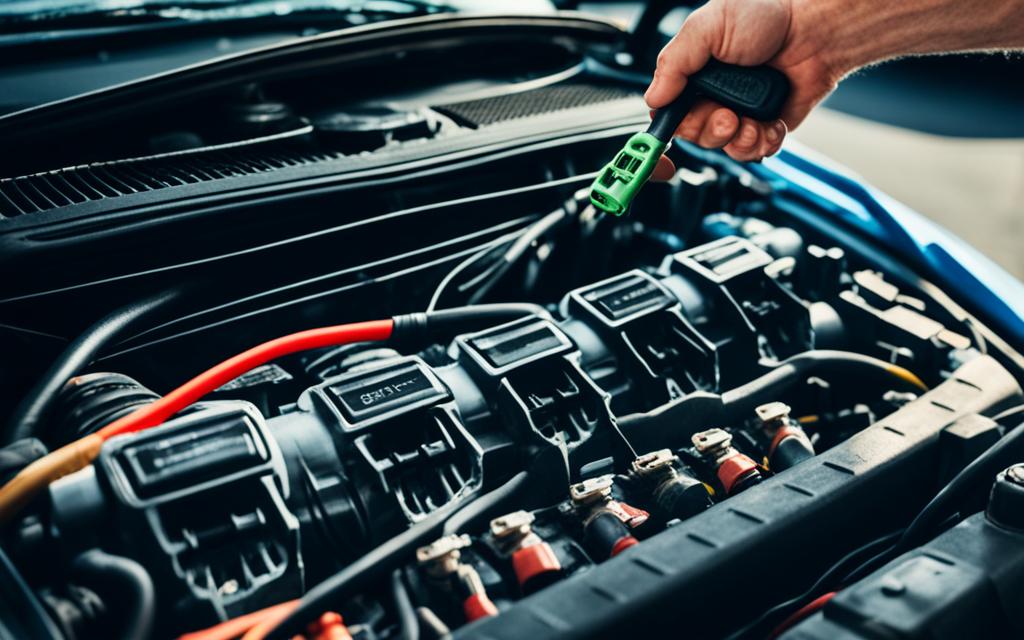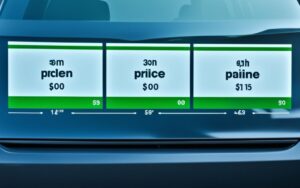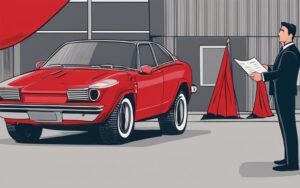Is your car making a clicking noise when you try to start it? Don’t worry; we’re here to help! In this section, we’ll provide you with quick tips to troubleshoot and fix the issue. We’ll cover common causes of the problem and offer simple solutions to get your vehicle back on the road in no time.
Key Takeaways:
- Understanding the car clicking noise will help you pinpoint the problem more accurately.
- A dead battery or poor connection can be the culprit behind the clicking noise; check your battery and its connections.
- A faulty starter motor could also cause the clicking noise; learn how it works and troubleshoot accordingly.
- Issues with the solenoid and ignition switch are common causes of the clicking noise; learn how to diagnose and fix them.
- A defective starter relay and a faulty alternator may be contributing factors; understand how to identify and address these issues.
Understanding the Car Clicking Noise
Before we dive into the fixes, let’s take a moment to understand what the car clicking noise could indicate. By familiarizing yourself with the different sounds your car can make when starting and learning how to identify a clicking noise, you’ll be better equipped to diagnose and address the issue.
When you turn the ignition key, your car should start smoothly, without any strange noises. However, if you hear a repetitive clicking sound coming from under the hood, it could be a sign of a problem.
A car clicking noise can vary in intensity and duration, and it may occur as rapid repeated clicks or a single click. It’s often described as a rapid tapping, ticking, or chattering sound.
Here’s how to identify if the sound you’re hearing is indeed a clicking noise and not another type of noise:
- Listen for a distinct clicking sound: Pay attention to the rhythm and pattern of the noise. A clicking noise will typically have a consistent, repetitive pattern.
- Check for simultaneous electrical issues: If you notice that your lights are flickering, or if other electrical components aren’t working correctly, it could be related to the clicking noise.
- Consider the location of the sound: The clicking noise is frequently heard from the engine compartment, indicating that it may be engine-related. However, it’s important to rule out other potential sources, such as the starter or other mechanical components.
Identifying the car clicking sound correctly is crucial as it can help you narrow down the possible causes. Stay tuned for the next section, where we’ll explore common reasons why your car may be making a clicking noise when trying to start.
Dead Battery or Poor Connection
In many cases, a dead battery or poor connection can be the reason why your car won’t start and only makes clicking noises. In this section, we’ll walk you through the steps to check your battery’s health and ensure it’s properly connected. If necessary, we’ll also provide instructions on how to jump-start your car to get it back on the road.
Checking the Battery
To determine if a dead battery is the cause of your car’s clicking noise, you’ll need to inspect it for signs of discharge. Start by opening your car’s hood and locating the battery. It’s typically a rectangular box with two cables attached to it.
Once you’ve found the battery, visually inspect it for any corrosion or damage. Corrosion can appear as a white or blue powdery substance around the battery terminals. If you notice corrosion, you’ll need to clean the terminals using a wire brush and a mixture of baking soda and water.
Next, test the voltage of your battery using a multimeter. Set the multimeter to DC volts and connect the red probe to the positive terminal (+) of the battery and the black probe to the negative terminal (-). A healthy battery should have a voltage reading of around 12.6 volts. If the reading is significantly lower, your battery may be discharged.
Ensuring Proper Battery Connection
In addition to a dead battery, poor connections can also lead to clicking noises when you try to start your car. Here’s how you can check and ensure the battery connections are secure:
- Turn off your car’s engine and make sure the ignition is off.
- Locate the battery terminals, which are typically labeled with a positive (+) sign for the red terminal and a negative (-) sign for the black terminal.
- Using a socket wrench or a pair of pliers, tighten the connections on both terminals. Ensure they are snug and not loose.
- If the terminals are corroded, clean them with a mixture of baking soda and water and a wire brush. Rinse with clean water and dry thoroughly before reattaching the cables.
Jump-Starting Your Car
If you’ve confirmed that your battery is dead and you can’t wait for a replacement, jump-starting your car can provide a temporary solution. Here’s how to jump-start your car safely:
- Find a functioning car with a similar battery voltage and park it near your car.
- Turn off both cars’ engines and engage the parking brakes.
- Open the hoods of both cars and locate the batteries.
- Using jumper cables, connect the red positive clamp to the positive terminal of your dead battery and the other red positive clamp to the positive terminal of the functioning car’s battery.
- Connect the black negative clamp to the negative terminal of the functioning car’s battery and the other black negative clamp to an unpainted metal surface on your car, away from the battery.
- Start the functioning car’s engine and let it run for a few minutes.
- Attempt to start your car’s engine. If it starts, let it run for a while to recharge the battery.
- Disconnect the jumper cables in the reverse order of how you connected them.
If jump-starting your car doesn’t work or the battery continues to die, it may be time to replace the battery.
Faulty Starter Motor
If you find that your car is clicking but won’t start, it’s possible that the culprit is a faulty starter motor. The starter motor is responsible for initiating the engine’s combustion process by turning the crankshaft. If it’s not functioning correctly, your car may struggle to start.
To understand if the starter motor is the cause of the issue, it’s important to know how it works. When you turn the ignition key, an electrical signal is sent to the starter motor, which then engages with the flywheel to start the engine. If you hear a clicking sound but the engine doesn’t turn over, it could indicate a problem with the starter motor.
To troubleshoot the starter motor, follow these steps:
- Check the battery: Make sure the battery is fully charged and in good condition. A weak or dead battery can prevent the starter motor from receiving enough power to start the engine.
- Inspect the wiring: Examine the wiring connections between the battery, starter solenoid, and starter motor. Loose or corroded connections can disrupt the flow of electricity and cause the starter motor to malfunction.
- Tap the starter motor: Use a mallet or a similar tool to gently tap the starter motor while someone tries to start the car. Sometimes, a stuck or worn-out starter motor can be temporarily revived by tapping it.
If these troubleshooting steps don’t resolve the issue, it may be necessary to replace the starter motor. Consult your vehicle’s manual or a professional mechanic for guidance on the specific replacement process for your car.
Troubleshooting a Faulty Starter Motor
| Steps | Result |
|---|---|
| Check the battery | Ensure the battery is fully charged and in good condition. |
| Inspect the wiring | Examine the connections for any signs of damage or corrosion. |
| Tap the starter motor | Gently tap the starter motor to see if it can be revived temporarily. |
| Replace the starter motor | If the issue persists, consider replacing the starter motor. |
Issues with the Solenoid
The solenoid plays a crucial role in engaging the starter motor of your car. When there are problems with the solenoid, you may experience a clicking noise but your car won’t start. In this section, we will guide you on how to diagnose solenoid issues and provide steps to fix or replace it if necessary.
To determine if the solenoid is causing the clicking but won’t start issue, you can follow these steps:
- First, make sure your car’s battery is fully charged and the connections are secure.
- Locate the solenoid, which is usually attached to the starter motor or the firewall of your car.
- Inspect the solenoid for any visible damage or loose wiring.
- Using a multimeter, check the continuity of the solenoid by connecting the meter’s probes to the solenoid terminals.
- If the multimeter shows no continuity or an open circuit, it means the solenoid is faulty and needs to be replaced.
In some cases, the solenoid may be integrated with the starter motor, requiring the replacement of the entire starter motor assembly. If you’re unsure about performing these diagnostics or replacing the solenoid yourself, it’s best to consult a professional mechanic.
Common Solenoid Issues:
Here are some common solenoid issues that can cause your car to click but won’t start:
| Issue | Symptoms | Fix/Replacement |
|---|---|---|
| Worn-out contacts | Intermittent clicking noise and failure to start | Replace the solenoid |
| Sticking plunger or plunger spring | Repeated clicking noise when the ignition is turned | Replace the solenoid or attempt to clean and lubricate it |
| Shorted windings | Clicking noise followed by no cranking sound | Replace the solenoid |
It’s important to address solenoid issues promptly as a faulty solenoid can lead to further damage to the starter motor or other electrical components in your car.
Problems with the Ignition Switch
The ignition switch is a crucial component in starting your car. If it’s faulty, it can lead to a frustrating situation where your car clicks but won’t start. In this section, we will guide you on how to test and troubleshoot the ignition switch to identify if it’s the cause of your car problems. We will also provide potential solutions to resolve the issue and get your car back on the road.
When your ignition switch is malfunctioning, it can disrupt the flow of electricity from the battery to the starter motor. This can result in a clicking noise when you try to start your car. To determine if the ignition switch is the culprit, follow these steps:
- Step 1: Check the battery – Ensure that your car’s battery has enough power. A weak or discharged battery can mimic the symptoms of a faulty ignition switch.
- Step 2: Test the ignition switch – Use a multimeter to check the continuity of the ignition switch. Follow the instructions in your vehicle’s manual to locate and test the switch. If the switch fails the continuity test, it may need to be replaced.
- Step 3: Inspect the wiring and connections – Faulty wiring or loose connections can also contribute to ignition switch issues. Examine the wiring harness and terminals for any signs of damage, corrosion, or loose connections. Repair or replace as necessary.
If you’ve determined that your ignition switch is indeed the problem, you have a few options to consider:
- Solution 1: Replacing the ignition switch – If the switch is beyond repair, you may need to replace it with a new one. Consult your vehicle’s manual or a qualified mechanic for guidance on the specific steps involved in replacing the ignition switch.
- Solution 2: Professional assistance – If you’re not confident in your automotive repair skills, it’s best to seek the help of a professional. An experienced mechanic can diagnose the issue accurately and replace the ignition switch if necessary.
Remember, a faulty ignition switch can lead to a car that clicks but won’t start. By following the steps outlined above, you can test and troubleshoot the ignition switch to determine if it’s the cause of your car troubles. Don’t attempt any repairs or replacements if you’re unsure; seek professional assistance instead.
Next, we’ll discuss another potential cause for a car clicking when trying to start: starter relay issues. Understanding the various components involved in starting your car will help you diagnose and fix the problem more effectively.
Ignition Switch Troubleshooting
| Symptoms | Possible Causes | Solutions |
|---|---|---|
| Car clicking but won’t start | Faulty ignition switch |
|
| Weak or discharged battery | Insufficient power supply |
|
Starter Relay Issues
When you try to start your car and hear a clicking noise, the starter relay may be the culprit. The starter relay is responsible for controlling the flow of electricity to the starter motor, which initiates the engine’s rotation. If the relay is defective, it can hinder the starting process and result in the annoying clicking sound you’re experiencing.
To diagnose starter relay issues, follow these steps:
- Locate the starter relay in your vehicle’s fuse box or relay panel. Refer to your car’s manual for the exact location.
- Inspect the relay for any visible signs of damage, such as burnt connections or a melted appearance.
- Use a multimeter to test the relay’s functionality. Check for continuity between the appropriate terminals as specified in your car’s manual.
- If the relay fails the continuity test or displays visible damage, it’s time to replace it.
- Remove the faulty relay by carefully pulling it out of its socket.
- Install a new relay by firmly inserting it into the socket, ensuring it is securely seated.
Replacing the starter relay can be a straightforward process, but if you’re unsure or uncomfortable with performing this task, it’s best to consult a professional mechanic. They have the expertise and tools to handle the repair safely and effectively.
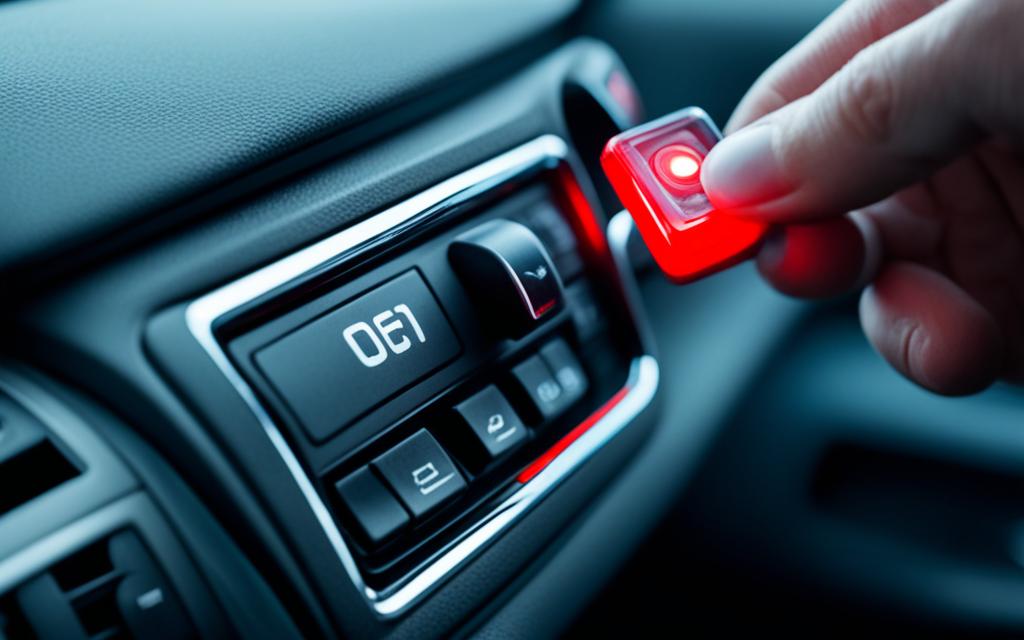
Remember, addressing starter relay issues promptly can help resolve the clicking noise and get your car back on the road.
Checking the Alternator
A common cause of a car that won’t start and only clicks is a faulty alternator. The alternator is responsible for charging the battery while the engine is running. If it malfunctions, it can lead to various electrical issues, including the clicking noise you’re experiencing.
To determine if the alternator is contributing to the problem, follow these troubleshooting steps:
- Start by visually inspecting the alternator. Look for any loose or damaged cables, as well as signs of corrosion.
- Next, use a multimeter to test the voltage output of the alternator while the engine is running. A healthy alternator should typically produce a voltage between 13.8 and 14.4 volts.
- If the voltage is significantly lower or higher than the normal range, it may indicate a problem with the alternator.
- Additionally, check the alternator belt for proper tension and any signs of wear. A loose or damaged belt can affect the performance of the alternator.
If you determine that the alternator is the cause of the clicking noise and your car won’t start, here are some potential fixes or replacements:
Fix: In some cases, a faulty alternator may be repairable. You can consult a professional mechanic to assess the extent of the damage and possibly repair the alternator components.
Replacement: If the alternator is beyond repair or the cost of repairs is too high, replacing the alternator is often the best solution. Ensure you choose a high-quality alternator compatible with your vehicle make and model.
Remember, it’s important to address alternator issues promptly as they can lead to further damage to your car’s electrical system. If you’re unsure or uncomfortable with diagnosing and fixing the alternator yourself, it’s recommended to seek professional assistance.
| Symptoms of a Faulty Alternator | Possible Causes |
|---|---|
| Dimming headlights or interior lights | Worn-out alternator brushes |
| Dead battery despite regular charging | Defective voltage regulator |
| Electrical malfunctions (e.g., malfunctioning power windows or radio) | Failed diodes within the alternator |
Continue reading to explore other possible causes and solutions for a car that won’t start and only clicks.
Other Possible Causes and Solutions
In addition to the common causes discussed in previous sections, there are a few other potential reasons why your car may click when trying to start. Understanding these causes and their respective solutions can help you resolve the issue and get your car back on the road.
1. Bad Ignition Coil
An ignition coil is responsible for providing the spark required to start the engine. If the ignition coil is faulty, it can result in a clicking noise when you turn the key. To diagnose this issue, you can use a multimeter to check the resistance of the ignition coil. If it exceeds the recommended range, it may need to be replaced. Consult your vehicle’s manual or a professional mechanic for specific instructions.
2. Damaged Starter Gear
The starter gear, also known as the flywheel or flexplate ring gear, engages with the starter motor to turn the engine. If the starter gear is damaged or worn out, it may cause a clicking noise. Inspect the starter gear for any signs of damage or missing teeth. If necessary, you may need to replace the starter gear to resolve the issue.
Remember, it is always recommended to consult a professional mechanic if you are unsure about diagnosing or fixing these issues. They have the expertise and tools to accurately identify the problem and provide the appropriate solutions.
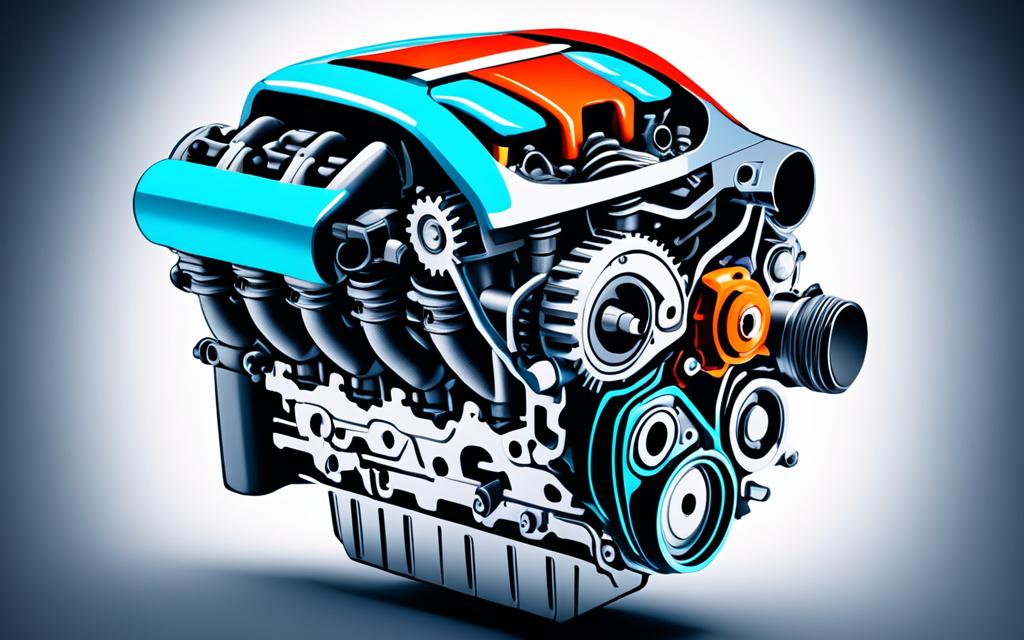
“Proper diagnosis is crucial when troubleshooting car issues. Be thorough in your inspections and seek professional help if needed.”
| Possible Cause | Solution |
|---|---|
| Bad Ignition Coil | Check resistance using a multimeter and replace if necessary |
| Damage to the Starter Gear | Inspect for damage or missing teeth and replace if required |
Conclusion
In conclusion, dealing with a car that clicks when trying to start can be a frustrating experience. However, the good news is that this issue often has a relatively simple solution. By understanding the common causes and following the quick tips provided in this article, you’ll be able to diagnose and resolve the problem, getting your vehicle back on the road in no time.
Remember, if you’re unsure or uncomfortable with any of the troubleshooting steps, it’s always best to consult a professional. They can provide expert guidance and ensure that the issue is properly resolved, avoiding any further complications.
So, stay calm and methodical when faced with a clicking car. With the knowledge gained from this article and a little patience, you’ll be able to quickly get to the root of the problem and take the necessary steps to fix it. Don’t let a clicking noise discourage you – you’ve got this!
FAQ
What could be causing my car to click when trying to start?
There are several possible causes for a car clicking when trying to start. It could be due to a dead battery or poor connection, a faulty starter motor, issues with the solenoid, problems with the ignition switch, starter relay issues, a faulty alternator, or other issues like a bad ignition coil or damaged starter gear.
How can I check if my battery is causing the clicking noise?
To check the battery, start by inspecting the connections to ensure they are clean and tight. If they appear to be in good condition, you can use a multimeter to test the battery’s voltage. If the voltage is low, it may need to be charged or replaced.
How do I troubleshoot the starter motor?
To troubleshoot the starter motor, you can try tapping it lightly with a mallet while someone else attempts to start the car. If the car starts after tapping the starter motor, it may indicate that the motor has a dead spot and needs to be replaced.
What should I do if the solenoid is causing the clicking noise?
If the solenoid is causing the clicking noise, you can try tapping it gently with a mallet while someone else tries to start the car. If this allows the car to start, it may indicate that the solenoid is sticking and needs to be replaced.
How can I test the ignition switch?
To test the ignition switch, you can use a multimeter to check the continuity of the switch’s electrical contacts. If there is no continuity or inconsistent readings, it may indicate that the ignition switch is faulty and needs to be replaced.
What steps can I take to diagnose starter relay issues?
To diagnose starter relay issues, you can try swapping the relay with a known working one from another part of the car. If the car starts with the swapped relay, it suggests that the original relay was defective and should be replaced.
How do I check if the alternator is causing the clicking noise?
To check the alternator, you can use a multimeter to test the voltage at the battery both before and after starting the car. If the voltage decreases significantly after starting, it may indicate that the alternator is not charging the battery properly and needs to be repaired or replaced.
What are some other possible causes of the clicking noise?
Other possible causes of a car clicking when trying to start include a bad ignition coil or damaged starter gear. It’s essential to perform a thorough diagnosis to determine the root cause and take appropriate steps to address the issue.

